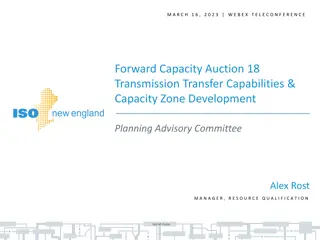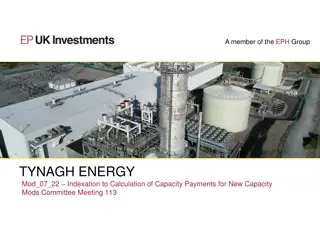
Geological Descriptions of Alpys, Deposit 94, and Priozernoye
Explore the geological descriptions of Alpys deposit in Pavlodar region, Deposit 94 in Atyrau region, and Priozernoye deposit in Zhambyl region. Learn about the locations, formations, reserves, and mining methods of these mineral deposits in Kazakhstan. Discover valuable information on ore compositions, depths, and related state reserve records.
Download Presentation

Please find below an Image/Link to download the presentation.
The content on the website is provided AS IS for your information and personal use only. It may not be sold, licensed, or shared on other websites without obtaining consent from the author. If you encounter any issues during the download, it is possible that the publisher has removed the file from their server.
You are allowed to download the files provided on this website for personal or commercial use, subject to the condition that they are used lawfully. All files are the property of their respective owners.
The content on the website is provided AS IS for your information and personal use only. It may not be sold, licensed, or shared on other websites without obtaining consent from the author.
E N D
Presentation Transcript
Alpys deposit in Pavlodar region Alpys deposit in Pavlodar region Location: Located in the Bayanaul district of Pavlodar region, 20 km from the operating Maikain mine. Brief Geological description: The object is located on the western flank of the Maikain ore field in the Maikain zone of the deep northeast-trending fault, which controls metasomatites of pyrophyllite-sericite- quartz composition on the main effusives. The length of the metasomatic zones is several kilometers, the width is up to 1500 meters. More than ten ore bodies concordant with the zones of metasomatic occurrence have been identified at the deposit. The dimensions of the main ore bodies reach the first hundreds of meters in strike and 200-300 meters in dip; their thickness varies from 1-3 to 10-15, less often 30-50 meters. The shape of the bodies is lenticular and sheet-like, the strike is submeridional, the dip is steep. The ores of the deposit are complex gold-pyrite-barite-polymetallic (Maikain type). The main ore components are gold, silver, and barite. Two main ore bodies, I and III, have been identified at the deposit, which contain about 90% of all reserves. The first ore body has an outcrop to the surface and up to a depth of 45-55 meters, and is represented by oxidized ores, below (up to a depth of 120 meters) - by sulfide ores. The remaining bodies occur at depths from 70 to 350 meters and are composed of primary (sulfide) ores. The contents in the ores are extremely uneven and vary within the following limits: gold - from traces to 300 g/t; silver - from the first grams to 1.7 kg/t; copper - 0.02-35%; lead - 0.01-24%; zinc - 0.01-28%; barite - 0.2-87%; sulfide sulfur - 0.15-48%. In addition to the main components, the ores contain dispersed elements: cadmium, indium, selenium, tellurium - Territory included in state subsoil fund management program for solid minerals extraction State reserve record as of 01.01.2023 - Contour of Alpys deposit Off-balance reserves - Reservoirs and buffer zones Component Balance reserves Gold, kg + + 1 5179 kg 2 - 124,6 kg 880,7 kg Copper, thous. t. + + 1 -43,3 2 1,2 thous. t. 4,4 thous. t.
Deposit Deposit 94 in Atyrau 94 in Atyrau region region Location: Located 15 km southeast of Inderborskiy settlement in the Atyrau region. Brief Geological description: The area of the deposit is composed of salt strata, eluvial formations of the gypcrete and Neogene Quaternary deposits. According to the conditions of formation at the deposit, two layers of rocks can be distinguished: bedrock salt deposits and gypcrete. Marine terrigenous formation, Khvalynian horizon; eluvial formations of a gypcrete of late Permian-Quaternary age along the boron-potassium horizon of the Shushaktau member of the Kurgantau formation of the Early Permian. The average thickness is 40 m. Most of the reserves are located below the groundwater level. The deposit is being developed by open-pit mining. Based on the experience of the Indersky mine, the watered ore body will be mined without draining the quarry. The overburden and host rocks of the ore body are represented by white and gray gypsums, anhydrite, and clays, as well as sand-clay deposits brought by ancient and modern karst. State reserve record as of 01.01.2023 Component Balance reserves Off-balance - Territory included in state subsoil fund management program for solid minerals extraction (reserve deposit contour) Ore + + 1-59,5 thous. t. - - + + 1-11,6 thous. t. Boron - -
Priozernoye Priozernoye deposit deposit in Zhambyl in Zhambyl region region Location: The deposit is located on the southern shore of Lake Kyzylautkol in the Zhambyl region, 30 km north of Karatau railway station, connected by a dirt road. Brief Geological description: In the collapse of chalcedony-bearing flints, trenches are spaced 20-100 m across the strike. Between the trenches, exploratory pits (2x2x1,2 m) are dug, and on the continuation of the trenches, shafts of 5 m deep are spaced 20-60 m apart. The core bodies are studied with 10-15 m deep boreholes spaced 50x50 m and 6-10 m deep shafts spaced 100x100 m; sampling is bulk. Within the terrigenous-carbonate strata of carboniferous age, with a thickness of 3500 m, the productive strata is localized at the top of the section; the joints between the underlying layers and the ore-bearing strata are clear. Chalcedony-containing flint bodies form positive relief in the form of asymmetrical ridges of W-NW strike and pillar-shaped elevations; heights range from 15 to 35 m. Sedimentary chemogenic; accumulation of silica in shallow seas by chemical precipitation, followed by metamorphism. 9 sections of flint collapse with reserves up to 1-1,5 m depth by categories B+C1 - 1450 tons have been developed. In the eastern part of the deposit, a section of indigenous bodies (depth from 1.5 to 7 m) has been identified with reserves in categories C1 + C2 - 251.4, developed by 25%. The areas have a rectangular shape, elongated along the strike of the layers of ore-bearing rocks - Territory included in state subsoil fund management program for solid minerals extraction (reserve deposit contour) State reserve record as of 01.01.2023 Component Balance reserves Off-balance Chalcedony 1-50,4 tons 2-9,2 tons -
East East- -Kozyrevsky deposit in Kostanay region Kozyrevsky deposit in Kostanay region Location: Located 6 km east of Oktyabrskiy settlement, 3 km from the worked-out Zimneye deposit. Brief Geological description: Cretaceous bauxite-bearing deposits fill a karst sinkhole in Lower Carboniferous limestones, which are in contact with effusive-sedimentary rocks of the same age. The depth of the karst depression is about 200 meters. Five ore bodies (1, 1a-1d) have been identified in the section of the bauxite-bearing deposits. Three of them - 1, 1a, 1b - contain industrial reserves, amounting to a total of 915.1 thousand tons. The ore bodies have a length of 70 to 100 meters, and their width does not exceed 100 meters. The minimum depth of the roof is 33.1 meters, and the sole of ore body 1b is located at a depth of 148.1 meters. The thickness of the bauxites in the ore bodies is 9.3 meters, 22.3 meters, and 25.9 meters. Characterizing the quality of the bauxites, it should be noted, on the one hand the high alumina content (45-47%) in the ore bodies, the low silica content (8-9%) and iron content (2-12%), and at the same time, the high carbonate content (on average for the deposit - 2.44%), organic matter (Sorghum about 1%) and pyrite up to 9%, which is reflected in the high sulfur content. According to Russian aluminium and magnesium institute (VAMI), the bauxites of the East- Kozyrevsky deposit are unsuitable for use at the Pavlodar plant due to their technological properties. The engineering-geological and hydrogeological conditions of the deposit's occurrence are assessed as complex (high water inflows into the quarry are expected at a high stripping coefficient). - Territory included in state subsoil fund management program for solid minerals extraction (reserve deposit contour) State reserve record as of 01.01.2023 Component Balance reserves Off-balance Bauxites 1-914,0 thous. t. - -
Aurtash deposit (western section) in Mangystau region Aurtash deposit (western section) in Mangystau region Location: Located 27 km southwest of Shetpe settlement and 50 km northeast of Aktau in the Mangystau region. Brief Geological Description:The deposit belongs to the barite-celestine type. It is confined to the Karas'yaz-Taspas anticline. The deposit structure is composed of sedimentary rocks of the Jurassic, Cretaceous, Paleogene, Neogene, and Quaternary periods of various genesis. Industrial mineralization is confined to the Middle Sarmatian shallow-water and coastal-shallow-water porous shell facies. Weak barite-celestine mineralization is traced in the Upper Paleocene-Lower Eocene sandstones. The ore horizon is represented by a sheet-like deposit, concordant with the enclosing rocks. It is distinguished by nest-like and veinlet-disseminated, nest-disseminated, nodular-cementation massive ores and continuous sheet-lenticular subconcordant bodies. The last one has the greatest practical interest. They gravitate to the lower basal layer of the Middle Sarmatian and are underlain by clays. The area of the ore-bearing horizon is 110 km . The mineralization extends for 11 km from southeast to northwest. The western flank of the deposit has been partially destroyed by erosion and has an oddly twisty boundary. The northeastern boundary is straight. The thickness of the Middle Sarmatian ore-bearing unit is 14.5 m. The depth of occurrence of the roof of the almost horizontal deposit is from 0 to 22 m. The thickness of the ore-bearing bed is from 0.5 to 11.5 m (average 3 m). The celestine content is from 5 to 85%. State reserve record as of 01.01.2023 Component Balance reserves Off-balance - Contour of reserve deposit Ore + + 1-792,0 thous. t. - - - Contracted territory of hydrocarbon + + 1-87,0 thous. t. Barite - -
Betbastau deposit in Zhetysu region Betbastau deposit in Zhetysu region Location: Located 20 km south of Sary-Ozek railway station in the Almaty region. Brief Geological description: Betbastau deposit, based on its morphological features, belongs to Group IV of complexity according to the State Committee on Reserves (GKR) classification. Taking into account the exploration group, reserves explored on a grid of less than 40x40 m are classified as category C1, while reserves explored on a grid of 40x40 m (mainly 40x80, 80x80 m) are classified as category C2.The reserves of the Betbastau deposit have been calculated to a depth of 100-120 meters. In total, there are 4 accounted blocks of category C1 and 3 accounted blocks of category C2. State reserve record as of 01.01.2023 Component Balance reserves Ore: 1-42 thous. t. Gold - 384 kg Ore: 2-122 thous. t. Gold - 779 kg Gold - Balance deposit - Contour of reserve deposit
Uzunmurt deposit in Karaganda region Uzunmurt deposit in Karaganda region Location: Located in the Nurinskiy district of the Karaganda region, 60 km southwest of Karaganda. Brief Geological description: The area of the deposit is composed of volcanic rocks of the Middle-Upper Ordovician with a blind intrusive body at a depth of 0.2-1.0 km. In the zone of foliation, more than 10 km long and 1.5 km wide, en echelon bedding of a series of quartz veins with a total length of 9 km is confined to the exocontact part of the blind intrusion. The length of the quartz veins is from 20 to 200-300 m, and their thickness is from 0.1 to 10.5 m. Two zones have been identified: Eastern and Western. The Eastern zone includes 4 sub-latitudinal veins with a total length of 440 m. The width of the zone with vein mineralization is 30-50 m, and the thickness of the quartz veins is 0.2- 10.5 m. The gold content ranges from 0.2 to 91.4 g/t. The increased gold concentration is confined to the hanging wall of the ore bodies. In one of the veins, the gold content in the ore column 3 m thick is 44-64 g/t with macroscopically visible inclusions. In a drill hole at a depth of 29-36 m, the gold content is 10.2-91.4 g/t for a thickness of 1.3 m. In other quartz veins, its concentration ranges from 0.1 to 21 g/t. The Western zone is represented by two staggered quartz veins with a thickness of 8-10 m and a length of 100-200 m. The total length of the zone is 400 m, and the width of distribution of the quartz veins is 80-100 m. They have been exposed by trenches. The distribution of gold in the ore bodies is extremely uneven, columnar from 0.1 to 10-20 g/t and more. State reserve record as of 01.01.2023 - Balance deposit Component Balance reserves - Contour of reserve deposit Ore: 1- 3,0 thous. t. Gold - 25,0 kg Ore: 2 - 2,0 thous. t. Gold - 13,0 kg - State geological study of subsoil Gold
Zhalair deposit in Karaganda region Zhalair deposit in Karaganda region Location: Located in the Michurinsky district, 45 km southwest of Karaganda and 75 km west of Karabas railway station. Brief Geological description: Barite autochthonous block of the Zhalair thrust and occur at the joint of conglomerates and sandstones of the Givetian-Franconian age with gray, dark gray limestones and marls of nodular and brecciated texture. Seven barite deposits have been identified and explored at the deposit, with lengths ranging from 120 m (ore body 7) to 400 m (ore bodies 1 and 2) and 1800 m (ore bodies 3, 4, 5, 6). The visible thickness is from 2 to 125 m in the swelling of ore body 1. The deposits are elongated in a chain from northeast to southwest for 18 km. On the western flank (4.5 km long), 11 barite bodies are localized. At depth they quickly wedge out. The joints of the bodies are unclear. The outlines of the deposits in the hanging wall are complex, probably due to karstic phenomenon in the Lower Famennian limestones. Near-ore alterations are expressed quartzification, potassium metasomatism, and epidotization. deposits are confined to the in recrystallization, silicification, - Territory included in state subsoil fund management program for solid minerals extraction (reserve deposit contour) State reserve record as of 01.01.2023 Component Balance Off-balance - Buffer zone of the dam + + 1 Barite, thous. t. 781 3194,8 - State geological study of subsoil
Ketmen Ketmen & & Predgorniy Predgorniy Ketmen Ketmen deposits deposits in Almaty in Almaty region region Location: Located in the Uyghur district of Almaty region, 60 km east of the village of Bolshoi Aksu and 42 km southwest of the village of Kalzhat. Brief geological characteristic: The indigenous sources of the placer are quartz and quartz-barite veins, zones of vein quartzification and pyritization in Lower Carboniferous tuffs. The placer has a complex structure. It is confined to the Pleistocene valley floor and the Middle Pleistocene terrace of basement and accumulative composition. Gold is dispersed throughout the section. The thickness of the peats is up to 10 m. Three industrial areas are distinguished within the placer: the first - 3400x61 m with a thickness of 0.8 m, the second - 1900x29 m with a thickness of 1.0 m, the third - 1600x30 m with a thickness of 0.9 m. The placer is discontinuous along the strike and has a bed-like shape with uneven gold distribution. Gold grains have lumpy and flat shapes. The average size of gold grains in the valley placer is 0.6 mm, in the terrace placer - 1.2 mm. Larger gold grains up to 3.5 mm occurs. The rounding of grains is poor. Magnetite, galena, and pyrite are constantly noted in the panned concentrate. The average gold content in the placer is 1.01 g/m . Mining and technical conditions for deposit development are simple. According to the mineragenic zoning, the rivers fall into the South-Ketmen gold-bearing area. The mountain zone of the Ketmen River valley rises above the piedmont part by 300-500 m and above the Shalkudysu River valley by 500- 1000 m. Absolute marks of the Ketmen ridge peaks range from 2800 to 3450 m. Alluvial formations of all accumulation cycles of the Ketmen River valley are dominated by sands and cobble-pebble deposits, as well as washed Neogene clays with rubble, sand, and pebbles. The thickness of these deposits varies from 2-3 m to 4-5 m, and on high above-floodplain terraces (second and third), it varies up to 20-25 m (within the modern valley). At the same time, the thickness of alluvium increases not only downstream the river, but also when transitioning from lower young above-floodplain terraces to higher ones. The basement for all gold-bearing cobble- pebble deposits is dense red-brown Neogene clays. - Balance deposit State reserve record as of 01.01.2023 - Territory included in state subsoil fund management program for solid minerals extraction (reserve deposit contour) Balance reserves Deposit Component Off-balance 1 2 Ketmen 59,4kg 46,3kg Gold Predgorniy Ketmen 329,05kg 90,29kg
Esymzhal deposit in Abay region Esymzhal deposit in Abay region Location: Located 230 km southwest of Semipalatinsk city on the territory of the former nuclear test site. Brief Geological description: The northwestern end of the Chingiz-Tarbagatai mega-anticlinorium and is located in the northern part of the western edge of the Murzhik syncline, composed of Devonian and Carboniferous volcano-sedimentary deposits. Three isolated sections (deposits): Southern, Central, and Northern, are distinguished within the deposit area. The ore body, with a thickness of 0.3-0.5 to 2.5-4.2 m, is confined to limestones, shales, and sandstones of the lower part of the Meisters horizon of the lower Famennian. Mineralization is traced almost to 200 m along the dip and more than 3 km with breaks along the strike and is represented mainly by oxidized minerals of pyrolusite-psilomelane composition with admixtures of braunite and vernadite. Lean primary ores are represented by banded varieties and are mainly composed of manganite, to a lesser extent, braunite, manganocalcite, and rhodochrosite. Oxidized pyrolusite-psilomelane-vernadite and primary manganite-braunite ores are identified in the deposit. deposit is associated with the - Territory included in state subsoil fund management program for solid minerals extraction (reserve deposit contour) State reserve record as of 01.01.2023 Component Balance Off-balance - Contour of the Semipalatinsk nuclear test site + + 1 2 Manganese, thous. t. 305,5 678,6 416,8 - Contour of revoked contracts
Mystobe sections in Karaganda region Mystobe sections in Karaganda region Location: Mystobe deposit is located near the railway line Almaty-Karaganda, 530 km northwest (by road) of Almaty and 120 km west of Balkhash. Brief geological description: Positioned at the junction of the Kyzylespinsky anticline and the West Balkhash syncline. The geological structure of the deposit involves early Carboniferous acidic volcanic rocks and mid-Carboniferous granitoids. Across the entire ore field, a sublatitudinal fault passes, spatially associated with ore bodies of submeridional and northeast extension. In fault zones, rocks are intensely altered and accompanied by aureoles of quartzification, chloritization, epidotization, and carbonatization. Ore bodies are associated with quartz-sericite metasomatites. More than ten ore bodies have been identified at the deposit, represented by tourmaline-pyrite- quartz veins and sulfide-quartz veins. The former form a system of intersecting submeridional and sublatitudinal fractures and are generally weakly gold-bearing. The latter form independent ore- bearing zones with submeridional orientation and complex morphology. Sections of veins with maximum thickness alternate with crush zones and veinlet quartzification zones. Their length reaches the first hundreds of meters. With depth, steeply dipping veins often flatten to a horizontal position. Vein composition: pyrite, chalcopyrite, molybdenite, galena, sphalerite, bismuthinite, tetradymite. The main non-ore minerals are quartz, carbonates, and tourmaline. Pyrite, to a lesser extent quartz, serves as the gold mineral concentrator. The content of ore minerals is 1-3%. The gold content is 32.3 g/t, with a fineness of 950-1000. The deposit features an intensively developed zone of supergene enrichment with a thickness of up to 10-20 m. It widely includes (up to 20%) limonite, hematite, malachite, azurite, chrysocolla, covellite, chalcosine, bismuthite, and bismuth. - Territory included in state subsoil fund management program for solid minerals exploration (section 5312) - Balance deposit State reserve record as of 01.01.2023 - Contractual territory of LLP "Astana-Time" Mystobe deposit. Contract 5376 from 03.09.2018 for gold mining. Off-balance reserves, kg Component Balance reserves , kg + + 1 808,7 Gold - 246,5
Pervomayskoye deposit in Akmola region Pervomayskoye deposit in Akmola region Location: Located in the Valikhanov district of the Akmola region, 20 km northeast of the Aksu mine. Brief Geological description: The deposit is in the zone of influence of a meridional fault and through northeast disruptions among Ordovician. It is represented by vein mineralization of gold-quartz-sulfide composition. Quartz veins of meridional strike are 50-250 m long and up to 0.5 m thick. Sulfides composition: pyrite, chalcopyrite, galena, sphalerite. The average gold content in worked- out ore bodies is 8.4 g/t. A linearly-areal weathering crust with a thickness of 20-30 m bearing weighted gold content is developed over the deposit area. The deposit deserves interest for its core gold. terrigenous-volcanogenic rocks of the State reserve record as of 01.01.2023 Component Balance reserves, kg Gold + + 1-731,55 - Pervomayskoye deposit. Contract 2122 from 28.06.2006 for solid minerals exploration. Contract revoked in 2020, the inspection act is absent Revoked contract of LLP "Emen Gold"
Tursun Tursun- -Tore Deposit in Zhetysu Region Tore Deposit in Zhetysu Region Location: The deposit is located in the Almaty region, 150 km from Mulaly railway station, and 40 km from the paved road Almaty-Leninogorsk. Brief Geological description: Discovered in 1966. Ore bodies are localized in tectonic fractures. The deposit is localized in Silurian-Devonian sedimentary- terrigenous deposits, intensively cleaved mineralization is plutogenic-hydrothermal gold-quartz mineral type, poor-sulfide ore formation. Near-ore alterations of host rocks are represented by quartzification - 1-2 m, and fragmentation - 1-3 m. Near-surface alterations of bodies are weakly expressed, with isolated nests and films of iron hydroxides, malachite, azurite observed in the near-surface part. and fragmented. The genesis of Hydrogeological conditions of development are simple the maximum water inflow into the mine workings (underground mining with adit opening) does not exceed 20 m /hour. Water supply: domestic - a spring with a flow rate of 1-1.5 l/sec, technical - water from the Tasty-Bien river 6 km from the deposit. State reserve record as of 01.01.2023 Off-balance reserves, kg - contour of deposit reserve Component Balance reserves, kg Gold + + 1 342 2 155 23
Kendirylykskoye Kendirylykskoye deposit, coal field (2nd coal deposit, coal field (2nd coal- -bearing formation) in East Kazakhstan region bearing formation) in East Kazakhstan region Location: The largest coal field in East Kazakhstan, the Kendirylykskoye Coal Field (2nd Coal-Bearing formation), is located in the Zaysan district of East Kazakhstan region, 50-65 km southeast of Zaysan. Brief Geological description: The coals of the deposit are confined to Middle-Upper Carboniferous (Kendirylyk formation), Upper Permian (Akkolkan formation), and Upper Triassic (Tologai formation) deposits. The Kendirylyk Formation contains one coal seam with a thickness of 2.1-2.7 m and two seams of combustible shales. Its coal-bearing capacity has been established only on the southwestern wing of the syncline and is traceable along the strike for 16 km. From 28 to 51 coal seams have been identified in the Akkolkan formation, of which only 10 have a working thickness of 0.6 - 1.6 to 5.1 m, with a total of 19 m. All seams have a complex, inconsistent structure. The deposits of the Tologay formation fill the central part of the syncline and contain up to 48 brown coal seams, of which 16 have a working thickness of 0.6 to 7.2 m. The total thickness of the working seams is 40 m. The coals of the first two formations are humic, bituminous, high-ash (from 19 - 30 to 45%), low-sulfur (0.4 - 0.9%), and in terms of metamorphism belong to the gas and partly to the long-flame coals. The heat of the combustible mass is up to 7.7 thousand kcal/kg; the yield of resin on dry coal is 3.7-10%. The coals of the Tologay formation are brown, foliated matte and dense semi-glossy. Their ash content varies within 10-55% (average 34%), they are low in sulfur, and the yield of resin during semi-coking is 6 - 10%. The reserves of bituminous coals to a depth of 1800 m are estimated at 587 million tons, and brown coals - at 1033 million tons (to a depth of 600 m). 73 million tons of bituminous coals and 67 million tons of brown coals are suitable for underground mining.The deep horizons of the Kendirylyk deposit are classified as inactive. The coals of the deposit are significant as energy fuel, and the coals of the Kendirylyk and Tologai formations can be used as raw materials for semi-coking and gasification. Coal reserves provide operating enterprises with resources for more than 50 years. State reserve record as of 01.01.2023 - Territory included in state subsoil fund management program for solid minerals extraction (reserve deposit contour) Off-balance reserves, thous. t. Component Balance reserves, thous. t. - State geological study of subsoil - buffer zone of an inhabitant locality + + 1 10043 2-0 Coal
Tiyesai deposit in Zhambyl region Tiyesai deposit in Zhambyl region Location: The deposit is located in the Sarysu district of the Zhambyl region. Brief Geological description: The deposit extends up to 65 km with a width of up to 700 km. The deposit area is 32 km . The deposit is developed with terrigenous formations of the Karaoy series of the Upper Proterozoic and Cambrian carbonate deposits of the Tamdyn series. Phosphorite-bearing deposits of the Chulaktau formation, lying at the base of the Tamdyn series, are associated with the stratigraphic contact. The phosphorite horizon at the deposit is represented by a single layered body. Two phosphorite packs separated by a layer of phosphatic conglomerates with a thickness of up to 7.2 m are distinguished. fluorapatite, calcium phosphate, carbonates. Phosphate Phosphate material is part of oolites, pseudo-phosphates, and phosphate fragments. The deposit is predominantly composed of siliceous-phosphate ores, less so of carbonate- siliceous-phosphate ores. minerals: State reserve record as of 01.01.2023 - Territory included in state subsoil fund management program for solid minerals extraction (reserve deposit contour) Off-balance reserves, thous. t. Component Balance reserves, thous. t. Phosphorite ores + + 1 5472 2 17895 658 - Power lines
Kendirylykskoye Kendirylykskoye deposit, 1st coal deposit, 1st coal- -shale field in East Kazakhstan region shale field in East Kazakhstan region Location: The deposit is located in the Zaysan district of East Kazakhstan region, 50-65 km southeast of Zaysan. Brief Geological description: The coals of the deposit are confined to the Middle-Upper Carboniferous (Kendirylyk Formation), Upper Permian (Akkolkan Formation), and Upper Triassic (Tologay Formation) deposits.The Kendirylyk Formation contains one coal seam with a thickness of 2.1-2.7 m and two seams of combustible shales. Its coal-bearing capacity has been established only on the southwestern wing of the syncline and is traceable along the strike for 16 km. From 28 to 51 coal seams have been identified in the Akkolkan Formation, of which only 10 have a working thickness of 0.6-1.6 to 5.1 m, with a total of 19 m. All seams have a complex, inconsistent structure. The deposits of the Tologay Formation fill the central part of the syncline and contain up to 48 brown coal seams, of which 16 have a working thickness of 0.6 to 7.2 m. The total thickness of the working seams is 40 m. The Kendirylyk deposit includes the coal areas of Karaungur, Saykan, and Akkoyn, and the shale and brown coals of Areas 1 and 2. Combustible shales are located within the Kendirylyk deposit on the northwestern flank, 4-8 km from the industrial coal seams of the Karaungur and Saykan areas. The combustible shales are localized at three stratigraphic levels: the lower one - the Kendirylyk Formation; the middle one - the Karaungur Formation; and the upper one - the Taranchin Formation. The most productive is the lower stratigraphic level - the Kendirylyk Formation. - Balance deposit The shales of the Kendirylyk Formation have been studied most fully, while the shales of the Saykan Formation have been studied the least. - Territory included in state subsoil fund management program for solid minerals extraction (reserve deposit contour) State reserve record as of 01.01.2023 - State geological study of subsoil Component Balance reserves Off-balance - buffer zone of an inhabitant locality + + 1 11 281 thous. t. Coal 0 0
Kainazar Kainazar deposit in deposit in Zhambyl Zhambyl region region Location: Located northeast of Karatau city. Brief Geological description: The structure of the monocline is composed of arboniferous terrigenous-sedimentary deposits with a thickness of 3500 m, including a productive layer of clayey limestones and fine-grained marls of the Late Visean age. Within the horizon, 25 indigenous deposits and five deluvial scree of flints with colored chalcedony have been identified. The deposits are lenticular in shape, have a west-northwest strike, concordant with the strike of the enclosing rocks, and a north-northeast dip. Along the strike, the deposits are traced for 10-150 m (average 50 m) with a width of 2-100 m (average 25 m) and a thickness of 0.05-1.5 m (average 0.25 m). The deposits are characterized by sharp contacts with the footwall and hanging wall rocks, as well as weakly expressed surrounding zones of silicification (1-2 m wide) and chloritization (10-15 cm). From the surface to a depth of 1 m, the deposits are destroyed with the formation of deluvial scree of chalcedony-containing flints, inheriting the strike of the indigenous deposits. The mineral composition of chalcedony- containing flints is represented by chalcedony, quartz, and opal. Chalcedony has a hidden- crystalline microspherulitic structure (spherulite size - thousandths and hundredths of a mm); fibrous varieties are less common. Quartz in industrial chalcedony-containing flints is coarse- crystalline (up to 2.5 cm). Opal is rare at the deposit, forming close intergrowths with chalcedony. The color of technical chalcedony is bluish-gray; flints are gray, black, and red. Decorative chalcedony is characterized by cherry-red, honey color, high (7-7.5) hardness, conchoidal fracture, glassy sheen, and viscosity. Colored chalcedony is suitable for the production of jewelry and decorative items. The maximum yield of products from raw materials is 46%, on average 15%. - Territory included in state subsoil fund management program for solid minerals extraction (reserve deposit contour) - State geological study of subsoil State reserve record as of 01.01.2023 Off-balance reserves, Component Balance reserves, Gemstones + + 1 14,7 2 2,7 -
Tasty Tasty- -Bien deposit in Zhetysu Region Bien deposit in Zhetysu Region Location: Located in the Kopal district of Taldykorgan region, 80 km east of Taldykorgan. Brief Geological description: The deposit is of the quartz vein type. The ore- bearing rocks are Middle Devonian sandstone-shale formations. The sub- latitudinal vein zone has been traced by ditches for 200 m and is represented by two quartz veins 70 and 50 m long, 0.7 and 0.8 m thick with gold contents of 41.6 and 33.0 g/t, respectively. In vein 2, the gold content in a core sample at a depth of 20 m was 13.4 g/t. The veins are branching, of variable thickness (from 0.02 to 1.3 m) and strike, and have been traced by drill holes to a depth of 50-60 m. The composition of the veins are quartz (up to 85%), pyrite, chalcopyrite, galena, and sphalerite. Gold is free in quartz, up to 2 mm in size, and is extremely unevenly distributed (from 0.5 to 930 g/t). In a bulk sample weighing 45 tons, the gold content was 79 g/t. The deposit is small and underexplored. - Tasty-Bien deposit included in state subsoil fund management program for solid minerals extraction State reserve record as of 01.01.2023 - Licenses for geological study of subsoil Component Balance reserves Off-balance Gold + + 1 187 kg. 2 338 kg.
Bogembay Bogembay deposit in Akmola region deposit in Akmola region Location: The Bogembay deposit is located in the Alexevskiy district of Akmola region, 150 km northeast of Astana. Brief Geological description: In terms of orography, the deposit area is an undulating plain with absolute elevations of 300-400 meters, dissected by the Aksu River valley. The geological structure of the deposit is composed of terrigenous-sedimentary deposits of the Lower Carboniferous age (gray sandstones, siltstones, argillites, coal seams), forming a relatively small, synclinal structure (4x11 km), dissected by a tectonic fault into two troughs (Northern and Southern) (Fig. 12.1).According to their position in the section, lithological composition, fauna, and coal-bearing character, these deposits, by analogy with the Karaganda Basin, are divided into three formations. The industrial coal-bearing capacity is associated with the Karaganda formation, at the base of which a single complex coal seam with a thickness of 1-5 m is established. The seam consists of two interlayers, of which the lower one, with a thickness of 2.5 m, is of practical importance. The thickness of the upper layer sometimes increases from 0.6 m to 2 m, but usually it wedges out or is replaced by carbonaceous argillites. The maximum depth of occurrence of the coal seam is 400 m. The coals of the deposit are bituminous, humic, high-ash, and very difficult to beneficiate. The ash content of the coal mass is 35-45%, the sulfur content is 1.0-1.5%, the phosphorus content is 0.01- 0.02%, the calorific value on the combustible mass is 8000-8500 kcal/kg, the lower working fuel calorific value is 4500-5500 kcal/kg, and the volatile matter yield is 20-22%. Coals are weakly coking, with a plastic layer thickness of 8-12 mm. They belong to the OS grade and are suitable only as energy fuel. State reserve record as of 01.01.2023 - Bogembay deposit Off-balance reserves, thous. t. Component Balance reserves, thous. t. - Licenses for geological study of subsoil Coal 2-94703,6 + + 1 161883,4 -
Khairuzovskoye Khairuzovskoye deposit (inselberg 3, inselberg 2, inselberg 5) in deposit (inselberg 3, inselberg 2, inselberg 5) in Abay Abay region region Location: The deposit is located in East Kazakhstan region. Brief Geological description: The Khairuzovskoye deposit of wollastonites is composed of epidote-garnet-calcite-wollastonite skarns, localized as inselbergs 80- 320x40-50 m in size in the granodiorite massif, characterized by variable quality of useful minerals. Chemical Composition of Wollastonite (%): - SiO2 - 49.0, TiO2 - 0.1, Al2O3 - 2.1, Fe2O3 - 1.1, CaO - 41.1, MgO - 1.0, K2O - 0.3, Na2O - 0.2, K2O+Na2O - 0.5 Physical properties: bulk density - 2.89 g/cm , water absorption - 0.91% ,porosity - 11.4%, compressive strength - 8240 kg/cm Mineral composition of wollastonite skarn (%): wollastonite 52, quartz - 9.2, calcite - 17.8, garnet - 3.3, diopside - 6.9, epidote - 2.5, feldspar - 4.3, sphene - 0.2, others - 1.8. The obtained concentrate (after enrichment) meets the quality requirements for the paint, porcelain, electrical ceramics, abrasive, and other industries. State reserve record as of 01.01.2023 - Khairuzovskoye deposit (inselberg 3, inselberg 2, inselberg 5) included in state subsoil fund management program for solid minerals extraction Component Balance reserves Wollastonite + + 1 983,0thous. t. 2-101,0thous. t. - Licenses for geological study of subsoil
Surprise deposit in Karaganda region Surprise deposit in Karaganda region Location: The deposit is located in the Shet district of Karaganda region, 60 km east of Nura-Taldy settlement and 25 km northwest of the Alaygyr deposit. Brief Geological description: Discovered in 1981 by A.L. Burmak. The deposit is located in the Uspensk zone of deformation and is confined to the horizon of Lower Tournaisian limestones and aleurolites, which lie in the exocontact of the Late Permian Kuttu-Adam-Irek intrusive granite massif of the Akchatau complex. Alterations around the ore are expressed in intense contact metasomatism (Fig. 66). The ore-bearing formation dips monoclinally 30-500 to the northwest. One sheet-like ore deposit "Surprise" has been identified, striking northeast and east-northeast, dipping 30 to the northwest. Its length is 795 m, width is 15-65 m, and thickness is 11.5-36.5 m. The depth of the roof is from 0 to 150 m. A weathering crust is developed from the surface to a depth of 0-10 m.. Mineral composition of ore mass (%): Wollastonite - 35-70, Calcite - 16.5, Quartz and single grains of epidote, garnet, pyroxene State reserve record as of 01.01.2023 - Surprise deposit included in state subsoil fund management program for solid minerals extraction Off-balance reserves, thous. t. Component Balance reserves, thous. t. - Licenses for geological study of subsoil Wollastonite + + 1 755,3 2 2633,8 -






















